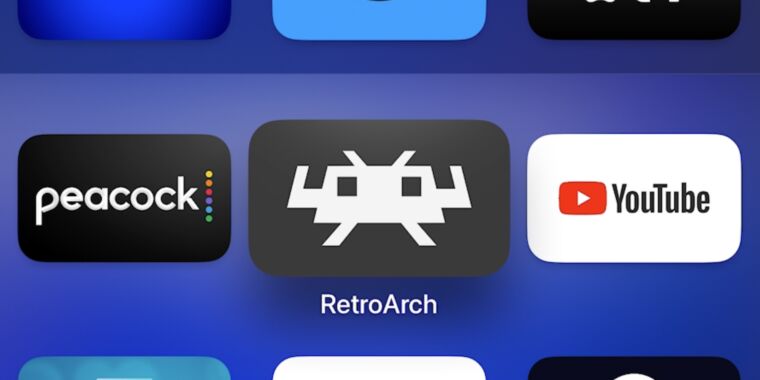Andrew Cunningham
Apple’s initial pitch for the tvOS and the Apple TV as it currently exists was centered around apps. No longer a mere streaming box, the Apple TV would also be a destination for general-purpose software and games, piggybacking off of the iPhone’s vibrant app and game library.
That never really panned out, and the Apple TV is still mostly a box for streaming TV shows and movies. But the same App Store rule change that recently allowed Delta, PPSSPP, and other retro console emulators onto the iPhone and iPad could also make the Apple TV appeal to people who want a small, efficient, no-fuss console emulator for their TVs.
So far, few of the emulators that have made it to the iPhone have been ported to the Apple TV. But earlier this week, the streaming box got an official port of RetroArch, the sprawling collection of emulators that runs on everything from the PlayStation Portable to the Raspberry Pi. RetroArch could be sideloaded onto iOS and tvOS before this, but only using awkward workarounds that took a lot more work and know-how than downloading an app from the App Store.
Downloading and using RetroArch on the Apple TV is a lot like using it on any other platform it supports, for better or worse. ROM files can be uploaded using a browser connected to the Apple TV’s IP address or hostname, which will pop up the first time you launch the RetroArch app. From there, you’re only really limited by the list of emulators that the Apple TV version of the app supports.
The main benefit of using the Apple TV hardware for emulation is that even older models have substantially better CPU and GPU performance than any Raspberry Pi; the first-gen Apple TV 4K and its Apple A10X chip date back to 2017 and still do better than a Pi 5 released in 2023. Even these older models should be more than fast enough to support advanced video filters, like Run Ahead, to reduce wireless controller latency and higher-than-native-resolution rendering to make 3D games look a bit more modern.
Beyond the hardware, tvOS is also a surprisingly capable gaming platform. Apple has done a good job adding and maintaining support for new Bluetooth gamepads in recent releases, and even Nintendo’s official Switch Online controllers for the NES, SNES, and N64 are all officially supported as of late 2022. Apple may have added this gamepad support primarily to help support its Apple Arcade service, but all of those gamepads work equally well with RetroArch.
At the risk of stating the obvious, another upside of using the Apple TV for retro gaming is that you can also still use it as a modern 4K video streaming box when you’re finished playing your games. It has well-supported apps from just about every streaming provider, and it supports all the DRM that these providers insist on when you’re trying to stream high-quality 4K video with modern codecs. Most Pi gaming distributions offer the Kodi streaming software, but it’s frankly outside the scope of this article to talk about the long list of caveats and add-ons you’d need to use to attempt using the same streaming services the Apple TV can access.
Obviously, there are trade-offs. Pis have been running retro games for a decade, and the Apple TV is just starting to be able to do it now. Even with the loosened App Store restrictions, Apple still has other emulation limitations relative to a Raspberry Pi or a PC.
The biggest one is that emulators on Apple’s platforms can’t use just-in-time (JIT) code compilation, needed for 3D console emulators like Dolphin. These restrictions make the Apple TV a less-than-ideal option for emulating newer consoles—the Nintendo 64, Nintendo DS, Sony PlayStation, PlayStation Portable, and Sega Saturn are the newest consoles RetroArch supports on the Apple TV, cutting out newer things like the GameCube and Wii, Dreamcast, and PlayStation 2 that are all well within the capabilities of Apple’s chips. Apple also insists nebulously that emulators must be for “retro” consoles rather than modern ones, which could limit the types of emulators that are available.
With respect to RetroArch specifically, there are other limitations. Though RetroArch describes itself as a front-end for emulators, its user interface is tricky to navigate, and cluttered with tons of overlapping settings that make it easy to break things if you don’t know what you’re doing. Most Raspberry Pi gaming distros use RetroArch, but with a front-end-for-a-front-end like EmulationStation installed to make RetroArch a bit more accessible and easy to learn. A developer could release an app that included RetroArch plus a separate front-end, but Apple’s sandboxing restrictions would likely prevent anyone from releasing an app that just served as a more user-friendly front-end for the RetroArch app.
Regardless, it’s still pretty cool to be able to play retro games on an Apple TV’s more advanced hardware. As more emulators make their way to the App Store, the Apple TV’s less-fussy software and the power of its hardware could make it a compelling alternative to a more effort-intensive Raspberry Pi setup.









